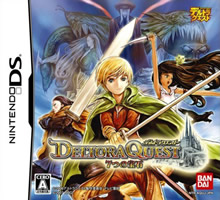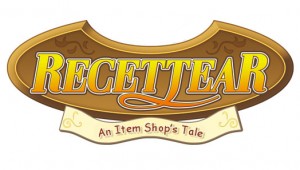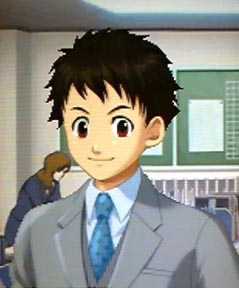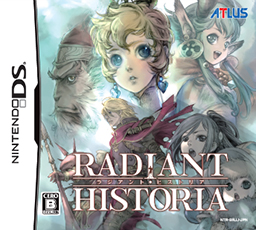 After my last post, I went back and did the last two quests I was missing (Garland’s “Moon Bracelet” and Rainey’s “End of the Journey” quests) and got the best ending. I think Rainey’s was the one that did the trick. I also switched Ath out for Rainey for the final boss battle this time. I hate to admit it but Rainey worked out even better because of Ath’s aforementioned weakness against screen-filling bosses. The “true ending” wasn’t very different from the other one except one last, very important scene, which I won’t spoil. Definitely worth getting if you can.
After my last post, I went back and did the last two quests I was missing (Garland’s “Moon Bracelet” and Rainey’s “End of the Journey” quests) and got the best ending. I think Rainey’s was the one that did the trick. I also switched Ath out for Rainey for the final boss battle this time. I hate to admit it but Rainey worked out even better because of Ath’s aforementioned weakness against screen-filling bosses. The “true ending” wasn’t very different from the other one except one last, very important scene, which I won’t spoil. Definitely worth getting if you can.
I’ve made a ton of posts about Radiant Historia so far, so I don’t have much left to say about it. It was great fun in the beginning, slowed down a lot and got rather dull and draggy towards the end, but ended on a high note so I’m pleased with it. If I had to play it again, I’d find a couple of days when I’m not playing anything else and just blast through RH without slowing down or pausing for thought.
Final thoughts? Firstly, anyone who’s looking for the “next Chrono Trigger” will have to keep looking. Radiant Historia is nothing like Chrono Trigger. If I had to compare it to another game, it would be a cross between Chrono Cross and Final Fantasy X, but even then not exactly. That doesn’t mean there’s no time or dimension travel in it, but it’s not as far reaching as CT’s. The game takes place over a maximum of one year and you can only go back and forth in that timespan. I haven’t played Radiata Stories, but as far as I know it’s not related to this game.
Secondly, Radiant Historia is not that intellectual. If you’re looking for a deep, thinking man’s game with lots of philosophy or discussion of life, the universe and everything, forget it. As I’ve documented time and again, the time travel plot is full of holes, and as for the sidequests, don’t even go there. They have their own continuity and trying to merge them into the main line is just asking to be made insane.
Time and dimension travel is extremely simplistic because the game runs on rails. You have to do a bit of thinking for the sidequests, but the main game story itself is 100% linear. You always know exactly when to go to the other timeline and when to come back. And just in case you don’t, the twins Tio and Lipty will usually show up and outright tell you or hint heavily as to what you should do. If you make a wrong choice, you see the consequences right away and then the twins bring you back to try again. Thus you bounce between the two continuities like a ping-pong ball, fixing what went wrong until you uncover the whole plot and bring the two timelines together again.
Speaking of which, trying to mentally reconcile the two timelines at the end will make your head explode (wait, so X died there, but is alive here, so is s/he alive in the combined timeline or not? Shouldn’t s/he be dead? But oh look, s/he’s not. So did event ABC happen or not? And which Character Y was taken into the combined timeline? Which memories does Y have, timeline A’s or B’s? Aaaarrrghhhhh *splat*), so I don’t recommend it.
The game doesn’t take place on a very grand scale either. Theoretically you’re trying to save the world, but in actual fact the game involves a few locations on one small continent that you visit repeatedly. As the game goes on, new locations are revealed, but they’re usually things that were there all along but you just didn’t have access to. There’s no overworld map per se, either, just dungeon-like places connecting one city to another (like FFXII, I guess). The enemies are also on a small scale, with a ton of palette swaps and very few original designs.
Don’t expect much by way of different endings either. Completing certain quests will give you certain extra scenes in the ending, and completing all of those certain quests will give you the “True” ending. In other words, apart from the “True” ending, each ending only varies from the others in terms of the number of scenes you get to see. It’s not like in say, Chrono Trigger where all the endings are different enough to make them each one worth seeing. Furthermore there’s nothing like New Game-only content or New Game Plus. The only good thing is that if you save after the ending, you can go back, fill more sidequests and aim for a better ending without restarting the game. Here’s a list of all sidequests (in Japanese), don’t ask me about them (update, I made a list in English). There are almost no missables in this game so don’t stress yourself out too much.
If you can bring yourself not to expect too much from the plot and the time travel mechanic, though, there’s plenty to love in Radiant Historia. The game soundtrack is fantastic, for one thing. I thought it matched the game exactly, and it didn’t sound like the average generic RPG BGMs that I’d heard a million times before. There was a medieval-and-yet-modern feel to it that matched the medieval-and-yet-modern state of the game world. The tunes never grated on my ears either, in fact sometimes I even turned the sound up. The “Bad Ending” tune was the best for me, but I loved the soft opening theme as well. Oh, and the Historia music. And the battle themes. And the Alicetel music. In fact I liked everything!
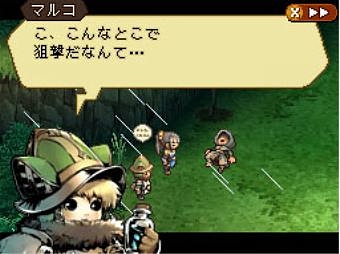 The visuals are okay enough, for a DS game. I liked the character designs (Ath!!) and I liked the sepia-toned palette. If I had to complain about one thing, it’s that the character portraits never change. No matter how happy or sad or angry a character is, they will always look exactly the same on the screen. When you couple that with the lack of voice-acting, it can be hard to get into the spirit of a scene sometimes. Especially when they’re obviously trying to elicit some emotion from you, they really should have made the visuals fit the mood.
The visuals are okay enough, for a DS game. I liked the character designs (Ath!!) and I liked the sepia-toned palette. If I had to complain about one thing, it’s that the character portraits never change. No matter how happy or sad or angry a character is, they will always look exactly the same on the screen. When you couple that with the lack of voice-acting, it can be hard to get into the spirit of a scene sometimes. Especially when they’re obviously trying to elicit some emotion from you, they really should have made the visuals fit the mood.
The characters are pretty likeable. It’s a minor point of discontent for me that the game never went much into their backgrounds, though. When I don’t like a character, I don’t care about their childhoods and where they came from, etc, but when I do, I can’t get enough of it. I would have liked to learn more about anyone other than Elca, Ath and Stock. I mean, you do get some comments here and there, but not nearly enough to satisfy your curiosity. There are some great side characters like Viola, Keel and Raul that you never really get to know much about. At the very least a character profile list or glossary or something, updated as the game goes along, would have been nice.
Gameplay was, of course, lots of fun. Because of the massive amounts of backtracking, you will usually be overleveled. Most normal battles aren’t much trouble, but a couple of sidequests will make you weep (Master Vancule, I’m sorry! Don’t hurt me any more!), though they can usually be beaten in one or two tries once you reevaluate your strategy. It’s nice to see things like Poison and Sleep working on many bosses, and your playable characters have different skillsets and abilities that make them unique, unlike the cookie-cutter fighters many RPGs tend to have. Not to mention I haven’t seen the grid thing outside of isometric SRPGs, so it was really fresh and new. Pushing enemies onto Ath’s deadly magic traps, oh, how sweet the satisfaction!
No gameplay system is perfect, though. Fighting does get a bit formulaic after a while, and it’s annoying when weak enemies chase you when they have no chance in hell of winning. There’s an ability that you can use to avoid battles, but you can’t use field abilities with it on so you have to take it off sometimes. Moreover this is one of those games where you’ll accumulate a ton of items you haven’t used by the end. Not because you’re being stingy, but because most fights aren’t challenging enough to force you to use them. Oh, and some of the items are just weak and useless. I’d like to see a Radiant Historia with a ‘Hard’ option to force me to bring out the depths of the battle system. If I ever do a replay, I’ll skip the sidequests so I can keep my level down a bit, then we’ll see.
Aaaannnddd… that’s it. I’ve blogged a ton about this game because I was looking forward to it. It came out, I got it, I played it, I really liked it and now it’s over. When it comes out in your area (Feb 22!), give it a shot, don’t expect too much and hopefully you’ll enjoy it like I did. Until then!
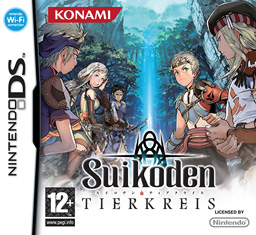 I remember mentioning long ago that I was playing Suikoden Tierkreis
I remember mentioning long ago that I was playing Suikoden Tierkreis. I finished it way back in August/September thereabouts, but never posted about it. And now I can barely remember what it was about.
